You might think as a certified English teacher, I had no qualms about teaching grammar to my children. However, our English language is complex. I also love grammar rabbit trails! I need a program detailed AND focused to keep me on track and not confuse my new grammar learners. I enjoyed Logic of English Foundations when I taught my kids to read in Kindergarten, 1st and 2nd grades. Now, we’re continuing our grammar learning with Logic of English Essentials. With Logic of English Essentials, you can teach grammar to multiple levels simultaneously!
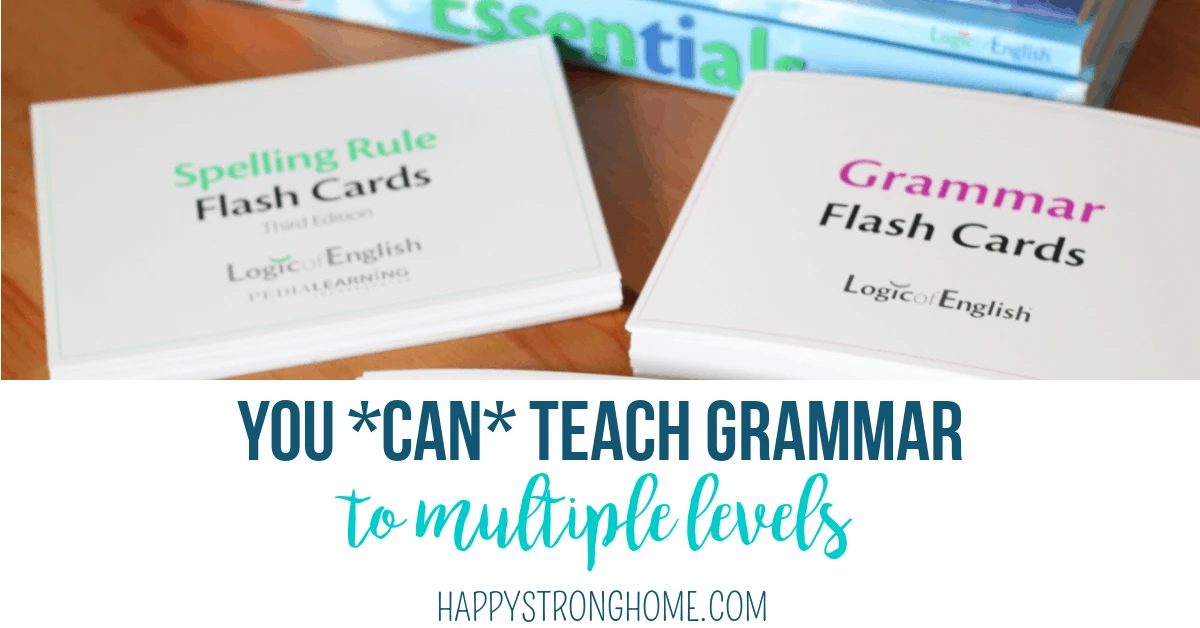
This post was sponsored by Logic of English, and I was sent items for review purposes but was not otherwise compensated. Affiliate links have been used in this post.
Elements of Logic of English Essentials Materials
The Logic of English Essentials program uses research-based methods to teach kids how to read, spell, and write.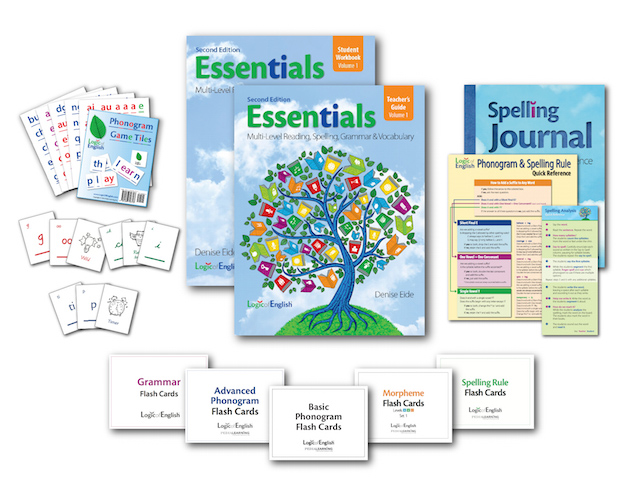
Currently, the program divides their thirty lessons into four sets of materials, so you don’t have to lug a gigantic textbook around. This also helps with the cost commitment, because you can order the next set when you’re ready. For this review, I used materials for Lessons 1-7:
- Essentials Teacher Guide (Lessons 1-7 book)
- Essentials Student Workbook (Lessons 1-7)
- Morpheme Cards (Lessons 1-7)
- Advanced Phoneme cards (good for all lessons)
- Grammar Rules (all lessons)
- Spelling Rules (all lessons)
- Essentials Spelling Journal (all lessons)
Sidebar: The Essentials Reader Program!
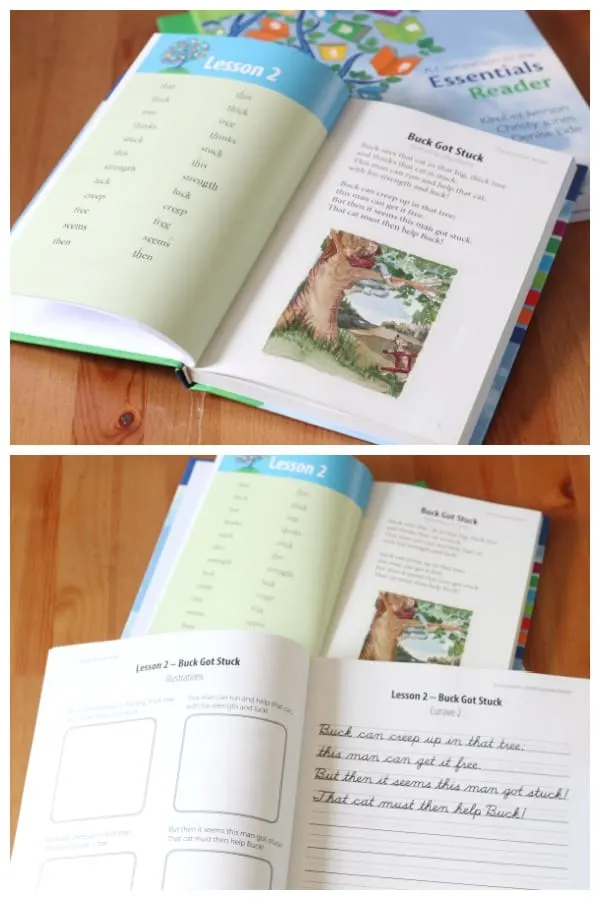
We also received the Essentials Reader program:
- Essentials Reader Teacher Handbook
- Essentials Reader Student Handbook
- Essentials Reader
The Essentials Reader introduces genres of writing and assists with vocabulary building. The teacher guide includes pre- and post- reading activities, and the lessons align with the Essentials grammar program.
My 9-year-old reads well-above grade level, so this Reader was too easy. Which makes sense, because the Essentials Reader is designed for the older student who struggles with reading. The Reader covers a lot of ground on the topic of writing genres, so we’ll continue reading the thirty passage to learn the various writing genres.
You CAN Teach Grammar to Multiple Levels
First you need to decide which level to place your kids at. The Logic of English Essentials is a spiraling curriculum giving you three years of application using the same concepts. Students complete the lessons at three levels: A, B, or C. This is why, if you have several kids, you can teach grammar to multiple levels, together!

Give each student the Placement Test, which involves various phonemic awareness activities and a spelling and reading list. My son misspelled one word far down the B list, then the first word of the C list. So I placed in him level B, to reteach spelling rules he’s rusty on.
Next, move onto either the pre-lessons or go directly to Lesson 1. Since my son’s completed all four levels of Logic of English Foundations, we skipped the pre-lessons. If your children haven’t done LOE Foundations, I recommend completing these lessons, as they’ll teach the nutshell of phonemic awareness.
Logic of English is known for their linguistically accurate phonics instruction. The scripted lessons make it basically an open-and-go curriculum.
As a certified English teacher, I always enjoy the teacher tips and notes in the sidebars. I have learned grammar facts and explanations never discussed in my college grammar classes (maybe I wasn’t paying attention then!? ha!). But just to highlight how invaluable the Logic of English instruction has been for me as a homeschool mom.
Scripted Lessons Help you Teach Grammar to Multiple Levels
Each scripted lesson has five sections:
- Essential Concepts (phonograms or spelling rules),
- Building Words (a spelling analysis lesson using their leveled lists),
- Words in Context (grammar rules),
- Words in Action (review, vocab, and dictation using spelling list words),
- Check Your Understanding (lots of review!).
The sections neatly divide the lesson for 5 days of instruction (if you like). This has made it easy for me to modify for a somewhat Charlotte Mason approach of “simple, short lessons.” Of course, you can condense as you see fit. Sections 2, 3, and 4 all start with review of the previous sections. Since my son is strong in phonics (thanks to LOE Foundations), we often skipped the phonogram reviews.
So how exactly DO we teach grammar to multiple levels?
After trying these lessons with my oldest son, I plan to consolidate our English lessons next year to save time! Each lesson includes sections taught to ALL students, then color-coded activities for levels A, B, and C. The concepts and general activities are the same, but word lists and level of skill increase as students level up.
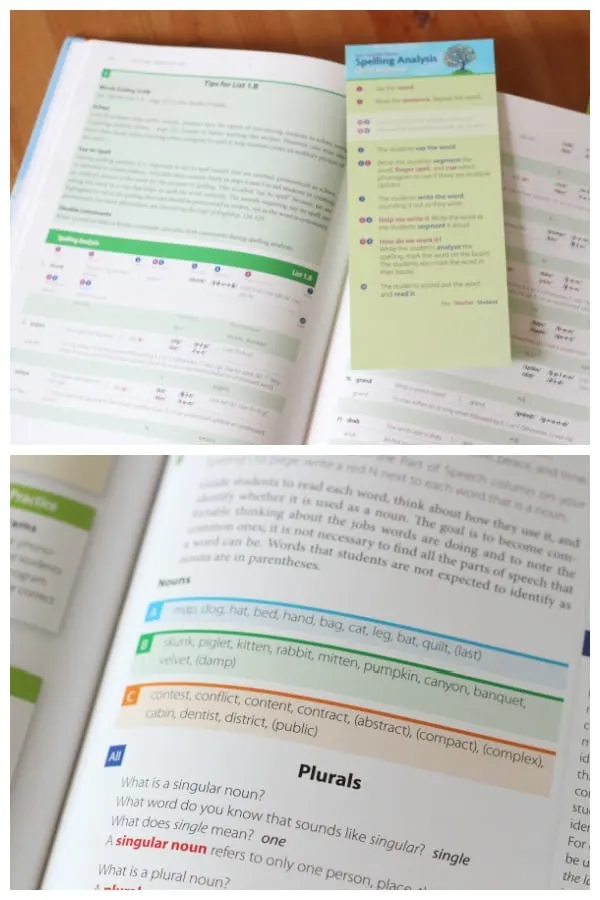
So you teach ONE lesson concept, then students work on that concept at their level!
- The first year, students learn grammar rules using Level A words.
- The second year, they learn the same grammar concept with more challenging words from Level B. Kids will think, “oh I think I remember that!” which is a great confidence-builder.
- The third year, teach the same lesson, using Level C words. By now, kids will think, “I know that!” so add a challenging layer like Latin roots and prefix/suffix skills to deepen their understanding of words.
Kids will not get bored, because you’re always deepening the learning by adding a layer of complexity. Kids will not feel overwhelmed because their spelling list is always at their reading level.
You will need time with each student for the various levels of Spelling Analysis. But spelling and grammar rule lessons can be done together, saving you tons of teaching time!
Plus… Have I mentioned the games? No? Just wait… but first I want to talk about how…
Grammar and Spelling Support Each Other!
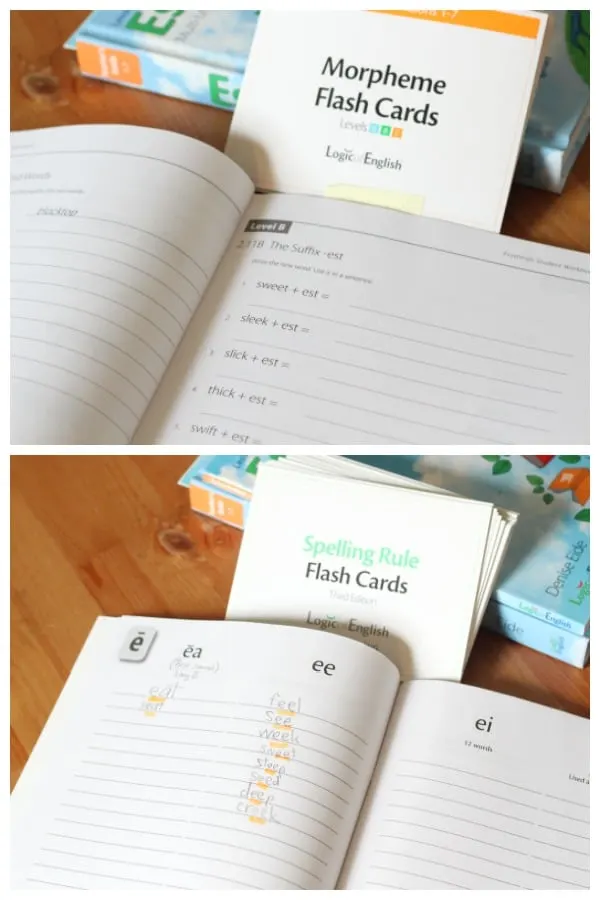
Logic of English Essentials weaves grammar and spelling together, supporting each other. They make a perfect pairing!
Introduce a grammar rule – such as Identifying Nouns. Ask students to identify the nouns on their own spelling list. With leveled spelling lists, a younger student at Level A will not struggle to identify that “feast,” “feelings,” (Level B) or “symptom” (Level C) are nouns. Instead, they’ll find easier nouns like “duck,” “corn,” and “milk.”
During noun identification, they’ll read and become familiar with their personal list of spelling words.
Students use spelling words throughout the lessons. Since the first few lessons are about nouns, the first spelling lists include loads of nouns! Makes sense, right? Here’s a few ways they use their lists:
- Copywork into their journal or notebook.
- List spelling words in the appropriate phonogram list in the Spelling Journal
- Use words in phonogram and grammar practice (pairing adjectives/nouns together to make silly phrases)
- Use them in dictation exercises
Spelling is always in context of the grammar rule they just learned!
Asking students to arbitrarily write sentences using spelling words often leads to a puddle of tears, or totally garbled sentences. But this way, students use what they know of the grammar concepts to create parts of sentences first, then add on as they learn additional grammar rules.
Honestly, I cannot imagine teaching spelling a different way!
Let’s not forget the games!
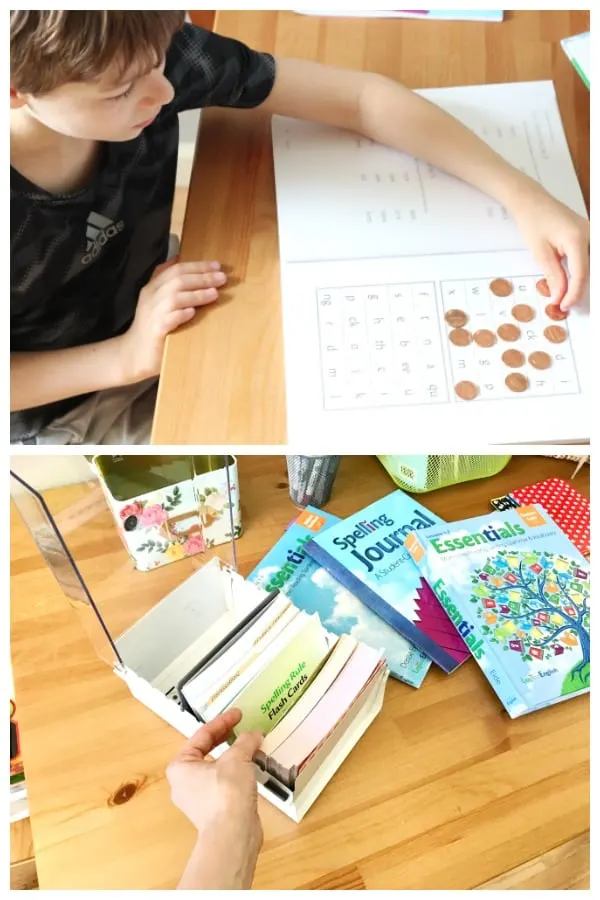
Finally, the games! (Because I realize most people don’t gush over grammar like I do!). Just like Logic of English Foundations, the lessons include games to play with phonograms, reading, and spelling:
- Phonogram Bingo
- Spelling Basketball
- Phonogram Go Fish!
- Phonogram Tile Crossword
You can probably figure out some of these games, but others have been created by Logic of English using the red/blue sets of Phonogram game cards which include the special playing cards needed for various games. Kids refresh their knowledge of phonemic awareness as they play. Modify for players of multiple levels by adjusting which cards you put out!
We use these games as part of our summer learning plan so we don’t forget all we’ve covered!
The Bottom Line…
I’ve taught grammar using many programs that have felt plodding or disconnected. By contrast, Logic of English Essentials connects each lesson to the one before, meaning learning doesn’t get lost or discarded along the way. (In teacher-speak, they “scaffold” the learning, to prepare students for the next lesson).
But which Logic of English program should you use? Ahhh!!! I have used and love both. But to help you decide:
If you have a young child, ages 4-5, I recommend starting with Logic of English Foundations, then move to Essentials (skipping Pre-lessons). (Get details about teaching phonics reading with Logic of English Foundations Level A, and building strong readers and writers with Logic of English Foundations Levels C, and Level D!)
If you have a range of children (with the youngest at 6?), simplify your grammar lessons to teach grammar to multiple levels simultaneously. I’d jump right into Logic of English Essentials with the Placement tests and Pre-Lessons.
I’ve covered a lot of ground, so let me know if you have questions about Logic of English Essentials Lessons 1-7! Stay tuned, because I’ll have a review on Lessons 8-15 for you in the fall!
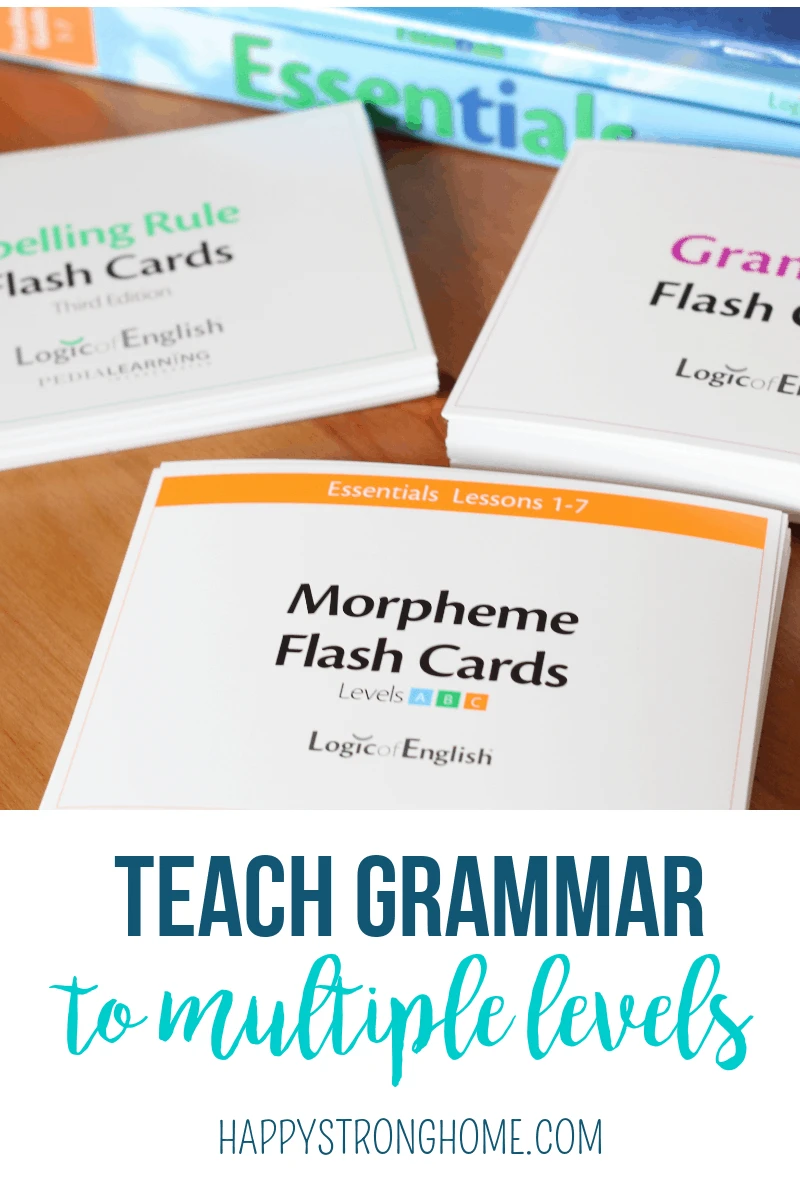
Thanks to Logic of English for providing materials for this review. All opinions are my own.


Ashley Halsey
Sunday 30th of August 2020
I am in the exact same situation as the above poster and have the same question!
Alysa Vos
Sunday 31st of May 2020
Hi! I came across this post while trying to figure out if it is reasonable to try to implement LOE with 3 kids at very different levels. Kid 1- zero reading ability , or phonogram I'd Kid2 - early reader rising 1st grade has cvc cvce words basic blends, Kid 3 2nd grader reading around 4th grade level but needs to continue with advanced reading, grammar, spelling. It looks awesome but very time intensive. I am worried about figuring out how to implement with 3 in top of math, and the all the good juicy stuff (lit, sci,as, art exploration).